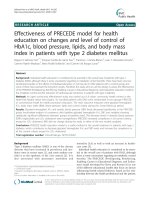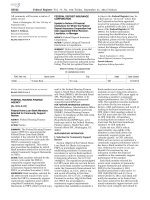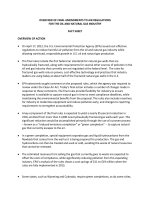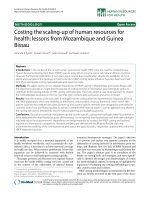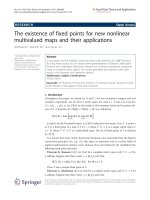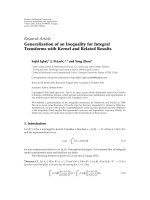Notice of Proposed Rulemaking for Marine Oil Terminal Engineering and Maintenance Standards
Bạn đang xem bản rút gọn của tài liệu. Xem và tải ngay bản đầy đủ của tài liệu tại đây (99.59 KB, 6 trang )
NOTICE OF PROPOSED RULEMAKING
BY
CALIFORNIA STATE LANDS COMMISSION
REGARDING THE 2001 CALIFORNIA BUILDING CODE
CALIFORNIA CODE OF REGULATIONS, TITLE 24, PART 2
MARINE OIL TERMINALS, CHAPTER 31F
Notice is hereby given that the California State Lands Commission (CSLC) proposes to adopt regulations.
The CSLC is proposing building standards related to Marine Oil Terminals, that will be codified in Chapter 31F,
California Code of Regulations (CCR), Title 24, Part 2.
PUBLIC COMMENT PERIOD
The CSLC Staff will hold a public hearing. It will start at 10:00 a.m. on July 13, 2004, at the Port of Long
Beach Board Room, 925 Harbor Plaza, Long Beach, CA 90802. The location is wheelchair accessible. At the
hearing, any person may present statements or arguments orally or in writing, relevant to the proposed
regulatory action described in the Informative Digest. It is requested, but not required, that persons making
oral comments at the hearing submit a written copy of their testimony at the hearing they attend.
Written comments will be accepted by the California State Lands Commission regarding the proposed
changes until 5:00 pm on July 13, 2004.
Please address your comments to:
Attention: Livin D. Prabhu
Marine Facilities Division
State Lands Commission
200 Oceangate, Suite 900
Long Beach, CA 90802
Written comments may also be submitted by facsimile to (562) 499-6317, attention Livin D. Prabhu or by email to "".
Pursuant to Government Code Section 11346.5 (a) 17, any interested person or his or her duly authorized
representative may request, no later than 15 days prior to the close of the written comment period, that a
public hearing be held.
POST-HEARING MODIFICATIONS TO THE TEXT OF THE REGULATIONS
Following the public comment period, the CSLC may adopt the proposed building standards substantially as
proposed in this notice or with modifications that are sufficiently related to the original proposed text and notice
of proposed changes. If modifications are made, the full text of the proposed modifications, clearly indicated,
will be made available to the public for at least 15 days prior to the date on which the CSLC adopts, amends,
or repeals the regulation(s). CSLC will accept written comments on the modified building standards during the
15-day period.
NOTE: To be notified of any modifications, you must submit written/oral comments or request that you be
notified of any modifications.
Notice of Proposed Action
Marine Oil Terminals, Chapter 31F
1 OF 6
05/21/2004
AUTHORITY AND REFERENCE
Public Resources Code (P.R.C.) Section 8755 directs the Commission to adopt rules, regulations and
guidelines for reviewing the location, type character, performance standards, size and operation of all existing
and proposed marine terminals within the state.
INFORMATIVE DIGEST
During the course of inspections at marine oil terminals carried out per Title 2, CCR Section 2320, the staff of
the California State Lands Commission (CSLC) determined that most, if not all, of these marine oil terminals
are ageing, with some built in the 1920’s. The average age is over 50 years. Design criteria for these facilities
were basically non-existent when they were built, or at least minimal when compared to present day practice.
In the last 20 years, “performance-based” design and analysis have been developed, to facilitate the
analysis/design of wharf/pier structures, subjected to seismic loads. Much has been learned from recent
earthquakes in countries with adequate building codes (e.g., Northridge, California (January 1994), Kobe,
Japan (January 1995) and Izmit, Turkey (August 1999)). These events and the resulting damage to coastal
structures have demonstrated that such damage can be significant and there is a real possibility of a major oil
spill resulting from such an earthquake (Izmit 1999). Seismic forces can be significant both in the lateral and
vertical directions and can produce destructive effects, resulting in danger to the public health, safety and the
environment. Seismologists predict moderate to severe earthquakes for the San Francisco Bay area and
Southern California, within the next 40 years. In addition, there has been a steady increase in the size and
deadweight of tank vessels berthing at marine oil terminals. These newer vessels impose substantially greater
loads on the terminal than the ones for which the terminal was originally designed.
In order to mitigate the potential effects of future earthquakes and to ensure the safest possible operation of
these terminals, the CSLC submitted a proposal to the Federal Emergency Management Agency’s (FEMA)
Hazard Mitigation Grant Program (HMGP), coordinated through the Governor’s Office of Emergency Services
(OES), for the Development of Seismic and Fire Regulations for Marine Oil Terminals and Related Facilities.
The proposal was accepted and a grant awarded. The CSLC provided additional funding for the non-seismic
portions of the effort.
The CSLC’s Marine Facilities Division (MFD) utilized the expertise of consulting engineers as contractors to
help draft Marine Oil Terminal Engineering and Maintenance Standards (MOTEMS). The MOTEMS
development process included two engineering workshops that included the representatives of the regulated
community (terminal owners and operators), engineering consultants, port engineers and engineering
academicians. Two other workshops, regarding the related topics of offshore seismic and tsunami hazards
were also held. Numerous meetings with the principal investigators of collateral projects (offshore seismic
hazards analysis and tsunami hazard analysis) were held to ensure the incorporation of appropriate data into
the proposed standards.
The process of developing the MOTEMS, has produced parallel guidelines and recommended provisions. The
“Seismic Design Guidelines for Port Structures,” published in 2001 by the International Navigation Association
(PIANC) uses text virtually identical to that found in the MOTEMS. The language for the PIANC and the
MOTEMS comes from the Naval Facilities Engineering Service Center Technical Report (TR-2103-SHR),
“Seismic Criteria for California Marine Oil Terminals,” that was funded and directed by the CSLC as part of the
Hazard Mitigation Grant project.
In addition, engineering staff of the CSLC has been directly involved in the development of standards at a
national level. A subcommittee of the National Earthquake Hazards Reduction Program (NEHRP), including
engineers from the MFD and the major ports of California, have developed a set of provisions that are being
adopted for the 2003 edition of the “NEHRP Recommended Provisions for Seismic Regulations for New
Buildings and Other Structures” (FEMA Publication 368). The seismic performance level proposed is the
Notice of Proposed Action
Marine Oil Terminals, Chapter 31F
2 OF 6
05/21/2004
same as that used in the MOTEMS and has been agreed upon for future use (new construction) by the Ports
of Los Angeles, Long Beach, Oakland and San Francisco.
The Marine Oil Terminal Engineering and Maintenance Standards were submitted to the Governor’s Office of
Emergency Services (OES) on July 17, 2002, thereby completing the Hazard Mitigation Grant Program
project. The standards as submitted to OES are “recommendations” and are currently published on the CSLC
website ( These standards have already been
used for the re-assessment of a major marine oil terminal in California.
The Hazard Mitigation Grant proposal called for the MOTEMS to be drafted into regulations. Consultation with
the staff of the California Building Standards Commission indicted that the appropriate legal approach would
be to codify the MOTEMS into the California Building Code (Title 2, California Code of Regulations, Part 2,
Chapter 31F).
With these new standards in place, the marine oil terminals of California are expected to remain in service, or
be repairable within months, following a major earthquake. In addition, all vessels, including the larger vessels
using these terminals, will now have a greater degree of safety when operating within the permissible
environmental operating limits (maximum wind, current and impact). Having marine oil terminals meet the
proposed Code will help ensure protection of the public health, safety and the environment from oil spills
resulting from earthquakes or excessive loads from vessels.
Summary of Existing Laws:
As Under Section 6111 of the Public Resources Code (P.R.C.), the CSLC is not to adopt building
standards directly. In accordance with instructions from the California Building Standards Commission
staff, the CSLC is therefore promulgating the proposed Marine Oil terminal Engineering and Maintenance
Standards (MOTEMS) as part of the California Building Code. The MOTEMS will be codified as Chapter
31F, California Code of Regulations (CCR), Title 24, Part 2.
PRC Section 8755 states, in part, “ …the commission shall adopt, rules, regulations, guidelines, and
commission leasing policies for reviewing the location, type, character, performance standards, size,
and operation of all existing and proposed marine terminals within the state, whether or not on lands
leased from the commission, and all other marine facilities on lands under lease from the commission
to minimize the possibilities of a discharge of oil. Rules, regulations, and guidelines adopted by the
commission shall not conflict with regulations of the administrator or the Coast Guard. The commission
shall ensure that the rules, regulations, guidelines, and commission lease covenants provide the best
achievable protection of public health and safety and the environment…“
The CSLC believes that the proposed standards accomplish these mandates.
Summary of Existing Regulations: There are no existing standards relating to the engineering analysis,
design, rehabilitation, inspection, or maintenance of marine oil terminals. There are no marine oil terminal
engineering standards or regulations known to the CSLC.
Summary of Effect:
Cost or savings to any state agency: None
Cost to any local agency or school district which must be reimbursed in accordance with Government
Code sections 17500 through 17630: None
Other non-discretionary costs or savings imposed on local agencies: Ports or cities may incur sizable
Notice of Proposed Action
Marine Oil Terminals, Chapter 31F
3 OF 6
05/21/2004
costs as a result of the inspections and the potential need for structural or other types of upgrading of
marine oil terminals within their purview.
Cost or savings in federal funding to the state: None
Comparable Federal Statute or Regulations None
Policy Statement Overview As mandated in PRC 8750-8760 the CSLC intends to prevent oil spills and
protect the public health and safety and the environment. The CSLC believes the proposed standards will
meet the mandates of these PRC sections and provide a better level of spill prevention and protection of the
public health and safety and the environment than currently exists.
OTHER MATTERS PRESCRIBED BY STATUTE APPLICABLE TO THE AGENCY OR TO ANY SPECIFIC
REGULATION OR CLASS OF REGULATIONS
None
MANDATE ON LOCAL AGENCIES OR SCHOOL DISTRICTS
The CSLC has determined that the proposed regulatory action would impose a mandate on local agencies
or school districts. Ports or cities that own, operate or lease marine oil terminals and private entities will
be affected by these proposed building standards. They will be obliged to comply with these standards,
when adopted.
INITIAL DETERMINATION OF SIGNIFICANT STATEWIDE ADVERSE ECONOMIC IMPACT ON
BUSINESSES
There will be some economic impact on businesses owning and/or operating marine oil terminals in the state,
as a result of the audit and analyses required by the proposed regulations. However, the impact may prove to
be beneficial or cost saving, in the long run. The Standards are designed in part to mitigate future seismic
induced damage to these facilities, thereby preventing oil spills and their associated costs. They also may
save the cost of downtime and repair, which can be very substantial. Mitigating seismic damage beforehand
may enhance the ability of businesses to compete with businesses elsewhere and certainly could prevent a
loss of commerce should a damaging earthquake occur.
A. Identification of the types of businesses that would be affected: Marine Oil Terminals
B. A description of the projected reporting, record keeping, and other compliance requirements that would
result from the proposed action:
Engineering audit reports, including structural analyses and above and below water inspection results and
recommendations. Proposed plans and schedules for implementation of repairs and upgrades as
necessary. Engineering records and documents regarding the marine oil terminal structure and systems
(electrical, mechanical, piping, firefighting, etc.).
C. The CSLC has made an initial determination that the adoption of this building standard may have a
significant adverse economic impact on businesses, including the ability of California businesses to
compete in other states. Private businesses (owners and operators of MOTs) may incur substantial costs
as a result of these proposed standards. Depending on engineering analyses and audit results, structural,
electrical or mechanical upgrading of part or all of a berthing system may be required. The intention of
these regulations is to ensure that these facilities are fit-for-purpose and that the best achievable
protection of the public health, safety, environment and the state’s infrastructure is being provided.
Notice of Proposed Action
Marine Oil Terminals, Chapter 31F
4 OF 6
05/21/2004
The CSLC has not considered proposed alternatives that would lessen any adverse impact on business
and invites interested parties to submit proposals that may be equally effective and less burdensome.
FINDING OF NECESSITY FOR THE PUBLIC'S HEALTH, SAFETY, OR WELFARE
PRC 8755(a) states, in part, that “…The Commission (CSLC) shall ensure that the rules, regulations,
guidelines, and commission lease covenants provide the best achievable protection of public health and safety
and the environment...” The Commission believes these proposed standards provide the protection
mandated.
COST IMPACT ON REPRESENTIVE PRIVATE PERSON OR BUSINESS
Private businesses (owners and operators of MOTs) may incur substantial costs as a result of these proposed
regulations. Depending on engineering analyses and audit results, structural, electrical or mechanical
upgrading of part or all of a berthing system may be required. The purpose of these standards is to ensure
that these facilities are fit-for-purpose and that the best achievable protection of the public health, safety,
environment and the state’s infrastructure is achieved.
ASSESSMENT OF EFFECT OF REGULATIONS UPON JOBS AND BUSINESS EXPANSION,
ELIMINATION OR CREATION
The CSLC has assessed whether or not and to what extent this proposal will affect the following:
1.
The creation or elimination of jobs within the State of California.
The proposal may create jobs within California because the amendments to the California Building Code will
require engineering audits. These audits are technical inspections that may be performed by the terminal
engineering personnel. However, MFD staff is aware that many of these terminals do not carry appropriately
qualified engineers on their staff; they will subsequently need to contract for these services. Because of the
number of terminals in the state, existing contracting engineering firms may find it necessary to hire additional
personnel to provide the needed services required by these proposed regulations within the timeframes
imposed therein.
2.
The creation of new businesses or the elimination of existing businesses within the State of California.
It will not create new businesses or eliminate existing businesses within California.
3.
The expansion of businesses currently doing business with the State of California.
The proposed Code may affect the expansion of businesses currently doing business within California, for the
reasons mentioned above. It may expand the marine construction industry, as these facilities perform the
required upgrades. Also, there may be purchase and installation of new equipment, pipelines, control systems
or other components, as the operator complies with the requirements of the proposed Code.
INITIAL DETERMINATION OF SIGNIFICANT EFFECT ON HOUSING COSTS
The CLSC has made an initial determination that this proposal WOULD NOT have a significant effect on
housing costs.
Notice of Proposed Action
Marine Oil Terminals, Chapter 31F
5 OF 6
05/21/2004
CONSIDERATION OF ALTERNATIVES
The CSLC must determine that no reasonable alternative considered by the state agency or that has
otherwise been identified and brought to the attention of the agency would be more effective in carrying out the
purpose for which the action is proposed or would be as effective and less burdensome to affected private
persons than the proposed action.
To date, no other alternatives have been presented to or considered by the CSLC, regarding Chapter 31F (24
CCR Part 2) of the State Building Code.
The CSLC invites interested persons to present statements or arguments with respect to alternatives to the
proposed regulations at the scheduled hearing(s) or during the written comment period.
AVAILABILITY OF RULEMAKING DOCUMENTS
All of the information upon which the proposed standards are based is contained in the rulemaking file, which
is available for public review, by contacting the person named below. This notice, the express terms and initial
statement of reasons can be accessed from the California State Lands Commission website,
/>CSLC CONTACT PERSON FOR PROCEDURAL AND ADMINISTRATIVE QUESTIONS
General questions regarding procedural and administrative issues should be addressed to:
Livin Prabhu, Supervisor, Planning Branch
Marine Facilities Division
California State Lands Commission
200 Oceangate, Suite 900
Long Beach, CA 90802
562-499-6400
562-499-6317 (fax)
Please direct requests for copies of the proposed text of the standards, the initial statement of reasons,
the modified text of the proposed standards, if any, or other information upon which the rulemaking is
based to Mr. Livin Prabhu at the above address.
PROPOSING STATE AGENCY CONTACT PERSON FOR SUBSTANTIVE AND/OR TECHNICAL
QUESTIONS ON THE PROPOSED CHANGES TO BUILDING STANDARDS
Specific questions regarding the substantive and/or technical aspects of the proposed changes to the building
standards should be addressed to:
Martin L. Eskijian, P.E., Supervising Engineer
Marine Facilities Division
California State Lands Commission
200 Oceangate, Suite 900
Long Beach, CA 90802
562-499-6312
562-499-6317(fax)
Notice of Proposed Action
Marine Oil Terminals, Chapter 31F
6 OF 6
05/21/2004

